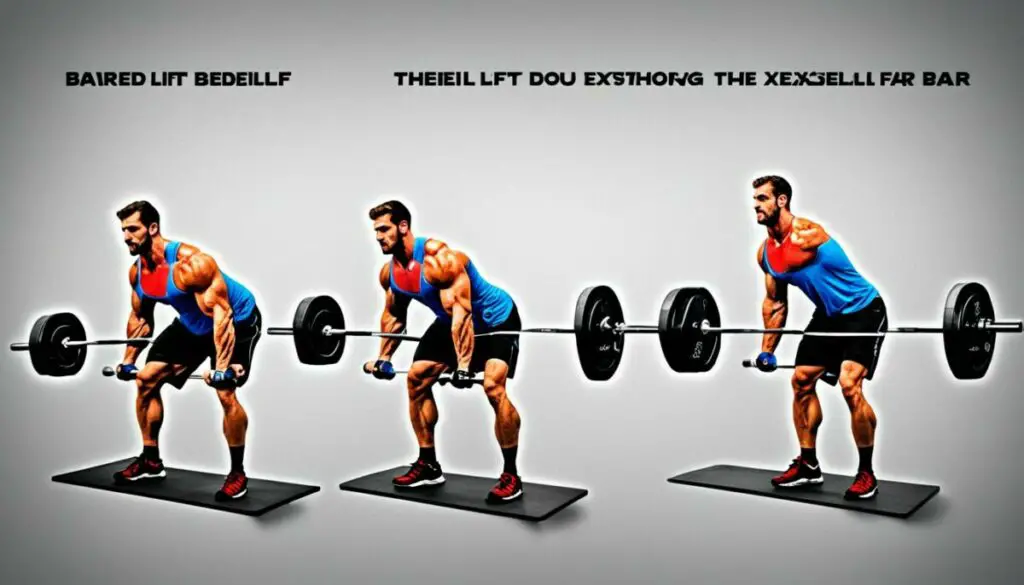Last Updated on 3 months by Francis
The hex bar deadlift has become a hot topic of discussion among fitness professionals, sparking debates about its safety compared to the traditional barbell deadlift. Many believe that the hex bar deadlift offers certain benefits that make it a safer alternative, while others argue that it may pose risks. In this article, we will dive deep into the facts surrounding the hex bar deadlift, exploring its advantages, proper form, injury prevention techniques, and comparing it to the conventional deadlift.
Before we delve into the details, let’s quickly explore the difference between the hex bar and barbell deadlift. The hex bar, also known as a trap bar, provides a unique lifting experience due to its shape and mechanics. This exercise allows for a more upright posture and places the load closer to the body compared to the barbell deadlift. As a result, the hex bar deadlift is often perceived as safer for the lower back.
- The hex bar deadlift is a topic of debate among fitness professionals regarding its safety compared to the traditional barbell deadlift.
- The hex bar deadlift offers a more upright posture and reduces lower back stress.
- Proper form, injury prevention strategies, and gradual progression are essential for a safe and effective hex bar deadlift.
- The hex bar deadlift engages multiple muscle groups, making it a compound exercise with numerous benefits.
- The choice between the hex bar deadlift and the conventional deadlift depends on personal goals and body mechanics.
Takeaways>
Contents
The Benefits of the Hex Bar Deadlift
The hex bar deadlift offers several benefits for strength training. It engages multiple muscle groups, including the back, glutes, hamstrings, quadriceps, calves, and forearms, making it a compound exercise that can contribute to overall strength and muscle development. Additionally, the hex bar deadlift allows for a more upright position, reducing stress on the lower back compared to the barbell deadlift. This can be beneficial for individuals with lower back issues or those who prefer a more comfortable lifting position.
Muscles Worked in the Hex Bar Deadlift
The hex bar deadlift effectively targets and works multiple muscle groups, providing a comprehensive workout. Here are the primary muscles worked during the hex bar deadlift:
| Primary Muscles worked in the Hex Bar Deadlift |
|---|
| Back (Upper and Lower) |
| Glutes |
| Hamstrings |
| Quadriceps |
| Calves |
| Forearms |
By engaging these muscle groups, the hex bar deadlift promotes overall strength, muscle development, and functional fitness. Incorporating this exercise into your strength training routine can help you achieve your fitness goals.
The Difference Between Hex Bar and Barbell Deadlift

The hex bar deadlift and the barbell deadlift are both variations of the deadlift exercise, but they have some key differences. These differences affect the lifting mechanics and body position, making the hex bar deadlift a unique exercise with its own set of advantages and considerations.
The hex bar deadlift involves stepping inside a hexagonal or diamond-shaped bar, which allows for a more upright posture and puts the load closer to the body. This positioning can help reduce stress on the lower back and provide a more comfortable lifting position. By engaging more leg muscles, such as the quadriceps and calves, the hex bar deadlift allows for greater power output and overall strength.
In contrast, the barbell deadlift requires lifting a straight barbell from the floor, which can put more stress on the lower back and requires a more forward-leaning position. While the barbell deadlift targets similar muscle groups, such as the back and glutes, it places a greater emphasis on the posterior chain muscles, including the glutes and hamstrings.
Ultimately, the choice between the hex bar deadlift and the barbell deadlift depends on individual goals, preferences, and body mechanics. The hex bar deadlift may be preferred by individuals with lower back issues or those seeking a more upright position. On the other hand, the barbell deadlift may be favored by those looking to specifically target the posterior chain muscles or prefer a different lifting experience.
Implementing both variations into a training routine can provide a well-rounded approach to deadlift training and optimize overall strength and muscle development.
Proper Form for Hex Bar Deadlift

To perform the hex bar deadlift with proper form, follow these steps:
- Step inside the hex bar and position your feet shoulder-width apart.
- Bend your knees and hinge at the hips, keeping your back straight and maintaining a neutral spine.
- Grip the handles of the hex bar firmly and engage your core.
- Push through your heels and drive your hips forward to lift the weight off the ground.
- Keep your chest up and your shoulders back throughout the movement.
- Lower the weight back down with control.
- Repeat for the desired number of repetitions.
Remember, maintaining proper form is crucial for maximizing the benefits and minimizing the risk of injury during the hex bar deadlift. Keep your back straight, engage your core, and focus on the movement of your hips and legs.
“Using proper form is essential for getting the most out of your hex bar deadlift and reducing the risk of injury. Keep your back straight, brace your core, and engage your glutes and hamstrings to lift the weight.”
Injury Prevention for Hex Bar Deadlift
Performing the hex bar deadlift incorrectly or using excessive weight can increase the risk of injury. To ensure a safe and effective hex bar deadlift workout, it is essential to follow proper injury prevention strategies. Here are some important tips to prevent injuries:
- Warm up properly: Prior to starting your hex bar deadlift workout, engage in a dynamic warm-up routine that includes exercises to increase blood flow, elevate body temperature, and activate the muscles you will be using during the workout. This can help prepare your body for the exercise and reduce the risk of strains or pulls.
- Use proper form and technique: Maintaining proper form is crucial for injury prevention during the hex bar deadlift. Ensure your back is straight, hips are hinged, knees are bent, and core is engaged. Avoid rounding your back or lifting with excessive momentum, as these actions can strain your lower back and lead to injuries.
- Start with lighter weights: If you are new to the hex bar deadlift or returning after a break, begin with lighter weights to allow your body to adapt to the exercise and gradually build strength. Starting with excessive weight can overload your muscles and increase the risk of injury.
- Gradually increase the load: As you become more comfortable and proficient with the hex bar deadlift, you can gradually increase the weight load. Progressing too quickly can strain your muscles and joints, so listen to your body and progress at a pace that feels challenging yet manageable.
- Listen to your body: Pay attention to any discomfort or pain during the hex bar deadlift. If you experience sharp or intense pain, stop immediately and seek guidance from a qualified fitness professional. It is important to identify and address any issues to prevent further injury.
Remember, injury prevention is a vital component of any fitness routine. By implementing these strategies and practicing caution, you can enjoy the benefits of the hex bar deadlift while minimizing the risk of injury.
Hex Bar Deadlift vs Conventional Deadlift

The hex bar deadlift and the conventional deadlift are two popular variations of the deadlift exercise, each with its own unique advantages and considerations.
The hex bar deadlift is often preferred by those looking for a safer alternative or a more comfortable lifting position. This variation allows for a more upright posture, reducing stress on the lower back. By stepping inside the hexagonal or diamond-shaped bar, the load is positioned closer to the body, enabling a more efficient and controlled lift.
Conversely, the conventional deadlift focuses on the posterior chain muscles, such as the glutes and hamstrings, to a greater extent. This exercise involves lifting a straight barbell from the floor, which requires a slightly more forward lean and places more stress on the lower back. The conventional deadlift is often favored by powerlifters and those looking to target specific muscle groups.
When deciding between the two variations, it’s important to consider individual goals, body mechanics, and personal preferences. The hex bar deadlift may be a better choice for individuals with lower back issues or those seeking a more comfortable lifting position. On the other hand, the conventional deadlift may be preferred by those specifically targeting posterior chain development or looking to compete in powerlifting.
Key Differences between Hex Bar Deadlift and Conventional Deadlift
| Hex Bar Deadlift | Conventional Deadlift |
|---|---|
| Allows for a more upright posture | Requires a more forward lean |
| Reduces stress on the lower back | Places more stress on the lower back |
| Engages different muscle groups | Emphasizes posterior chain muscles |
| Provides a more controlled lift | Requires a more precise technique |
Ultimately, both the hex bar deadlift and the conventional deadlift can be effective exercises for strength and muscle development. Experimenting with both variations and incorporating them into your workout routine can help you determine which one best suits your needs and goals.
Hex Bar Deadlift Variations
The hex bar deadlift is a versatile exercise that can be modified and varied to target different muscle groups and add variety to your workout routine. By incorporating these variations into your training, you can challenge different muscle groups, increase difficulty, and target specific areas of weakness. It is important to note that mastering the basic hex bar deadlift is essential before attempting these variations to ensure proper form and technique.
1. Single-Leg Hex Bar Deadlift
The single-leg hex bar deadlift is a unilateral exercise that focuses on balance, stability, and strength in each leg. To perform this variation, start by standing on one leg while gripping the handles of the hex bar. Hinge at the hips and lower the hex bar towards the ground while keeping your back straight and maintaining a neutral spine. Push through the heel of your standing leg to return to the starting position. Repeat for the desired number of repetitions and then switch to the other leg.
2. Deficit Hex Bar Deadlift
The deficit hex bar deadlift is a variation that increases the range of motion and places additional emphasis on the hamstrings and glutes. To perform this variation, stand on a stable platform or weight plates that elevate your feet slightly off the ground. Grip the hex bar handles and perform the deadlift with the increased range of motion. Ensure that you maintain proper form and engage your core throughout the movement.
3. Band-Resisted Hex Bar Deadlift
The band-resisted hex bar deadlift is a challenging variation that adds resistance at the top of the movement, increasing the intensity of the exercise. To perform this variation, attach resistance bands to both ends of the hex bar and secure them to an anchor point. As you lift the hex bar, the resistance bands will provide additional resistance, requiring you to exert more force to complete the movement. This variation can help improve explosive power and strength.
Remember to always start with lighter weights and gradually increase the load as you become comfortable with the variations. It is crucial to prioritize proper form, technique, and safety throughout your hex bar deadlift variations to maximize the benefits of the exercise and minimize the risk of injury.
| Variation | Muscle Groups Targeted | Benefits |
|---|---|---|
| Single-Leg Hex Bar Deadlift | Hamstrings, glutes, quadriceps, calves | Improved balance, stability, and unilateral strength |
| Deficit Hex Bar Deadlift | Hamstrings, glutes, lower back | Increased range of motion and emphasis on posterior chain muscles |
| Band-Resisted Hex Bar Deadlift | Full body | Improved explosive power and overall strength |
Try incorporating these variations into your strength training routine to add diversity, challenge your muscles in new ways, and take your hex bar deadlifts to the next level.
Muscles Worked in the Hex Bar Deadlift
The hex bar deadlift is a compound exercise that engages multiple muscle groups, making it a highly effective strength training movement. When performing the hex bar deadlift, the following muscles are primarily worked:
- Back (both upper and lower): The hex bar deadlift targets the muscles of the back, including the erector spinae, latissimus dorsi, and trapezius, helping to build overall back strength and stability.
- Glutes: This exercise engages the gluteal muscles, including the gluteus maximus, medius, and minimus, which play a vital role in hip extension and overall lower body power.
- Hamstrings: The hex bar deadlift works the hamstrings, located at the back of the thighs. Strengthening the hamstrings not only enhances lower body strength but also aids in knee stability.
- Quadriceps: This exercise targets the muscles located at the front of the thighs, including the quadriceps. Strengthening the quadriceps contributes to improved leg strength and stability.
- Calves: The hex bar deadlift also engages the calf muscles, including the gastrocnemius and soleus, which play a role in ankle stability and lower body power.
- Forearms: Gripping the hex bar during the deadlift movement activates the muscles of the forearms, such as the flexor and extensor muscles, enhancing grip strength.
In addition to targeting these specific muscle groups, the hex bar deadlift also engages the core muscles for stability and support throughout the exercise.
By incorporating the hex bar deadlift into your strength training routine, you can effectively target these muscles and promote overall strength and muscle development.
Conclusion
In conclusion, the hex bar deadlift offers several benefits and advantages compared to the conventional barbell deadlift. One of the key advantages is the ability to maintain a more upright posture, which reduces stress on the lower back. This makes the hex bar deadlift a safer alternative, particularly for individuals with lower back issues or those who prefer a more comfortable lifting position.
The hex bar deadlift also engages multiple muscle groups, including the back, glutes, hamstrings, quadriceps, calves, and forearms. This compound exercise promotes overall strength and muscle development, making it a valuable addition to any strength training routine. Furthermore, the hex bar deadlift has the potential to increase power output, providing a challenging and effective workout.
To ensure a safe and effective hex bar deadlift workout, it is important to maintain proper form, technique, and injury prevention strategies. This includes starting with lighter weights, gradually increasing the load, and listening to your body. By incorporating the hex bar deadlift into your strength training routine, you can take advantage of its benefits and enhance your overall fitness.
FAQ
Is the hex bar deadlift safer than the traditional barbell deadlift?
The hex bar deadlift is believed to be safer for many individuals because it allows for a more upright posture and reduces stress on the lower back.
What are the benefits of the hex bar deadlift?
The benefits of the hex bar deadlift include engagement of multiple muscle groups such as the back, glutes, hamstrings, quadriceps, calves, and forearms, making it a compound exercise that contributes to overall strength and muscle development.
What is the difference between the hex bar deadlift and the barbell deadlift?
The hex bar deadlift involves stepping inside a hexagonal or diamond-shaped bar, allowing for a more upright posture and putting the load closer to the body. The barbell deadlift requires lifting a straight barbell from the floor, which can put more stress on the lower back.
What is the proper form for the hex bar deadlift?
To perform the hex bar deadlift with proper form, start by stepping inside the hex bar with your feet shoulder-width apart. Bend your knees and hinge at the hips while keeping your back straight and maintaining a neutral spine. Grip the handles firmly, engage your core, and push through your heels to lift the weight off the ground.
How can I prevent injuries during the hex bar deadlift?
To prevent injuries during the hex bar deadlift, it is important to warm up properly, use proper form and technique, start with lighter weights, gradually increase the load, and listen to your body. If you experience discomfort or pain, modify the exercise or seek guidance from a qualified fitness professional.
What are the differences between the hex bar deadlift and the conventional deadlift?
The hex bar deadlift allows for a more upright posture and reduces stress on the lower back compared to the conventional deadlift. The conventional deadlift emphasizes the posterior chain muscles, such as the glutes and hamstrings, to a greater extent.
Are there any variations of the hex bar deadlift?
Yes, there are several variations of the hex bar deadlift, including the single-leg hex bar deadlift, deficit hex bar deadlift, and band-resisted hex bar deadlift. These variations can be used to challenge different muscle groups, increase difficulty, or target specific areas of weakness.
Which muscles are worked during the hex bar deadlift?
The hex bar deadlift primarily works the back (both upper and lower), glutes, hamstrings, quadriceps, calves, and forearms. It also engages the core muscles for stability and support.









